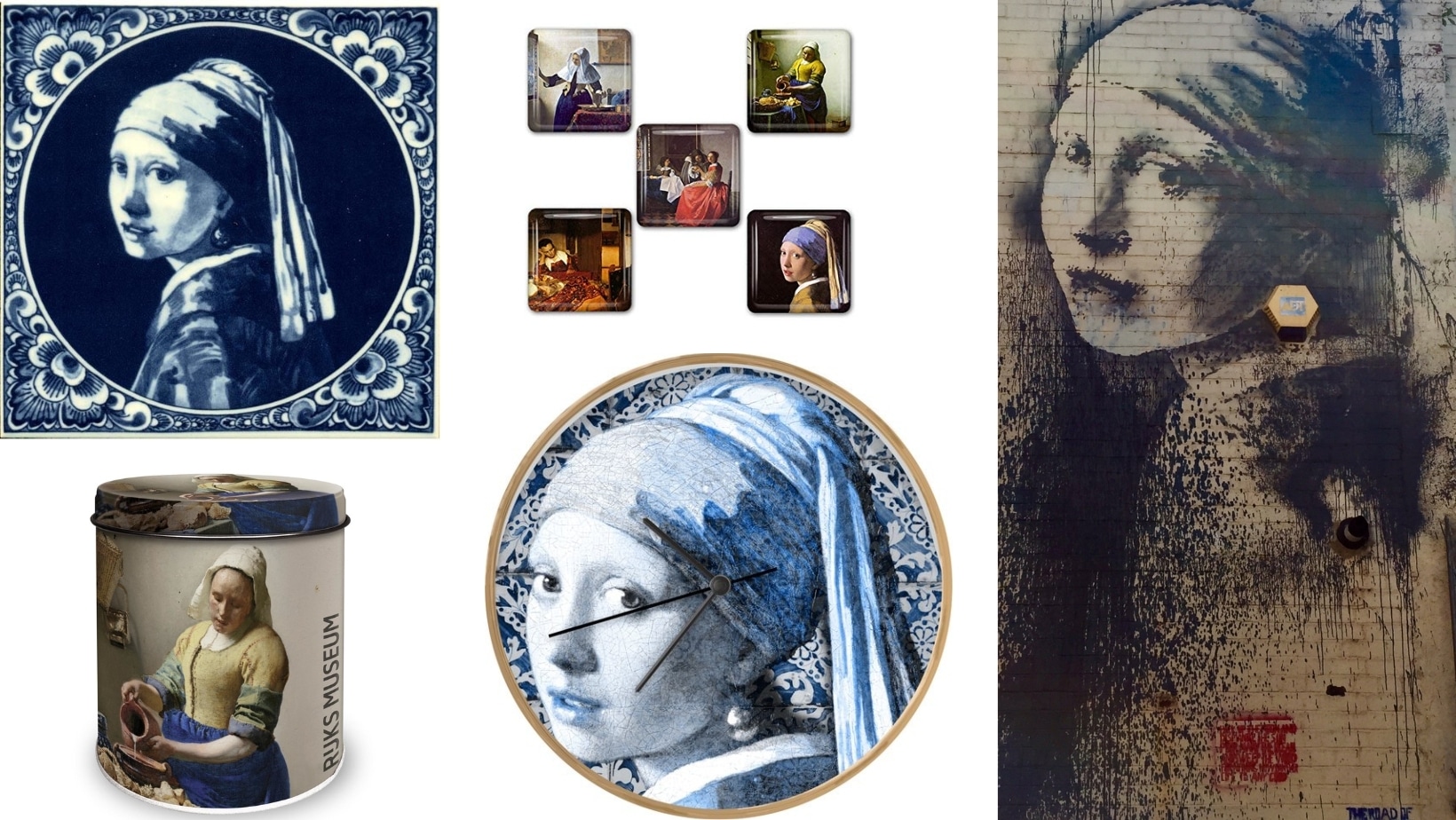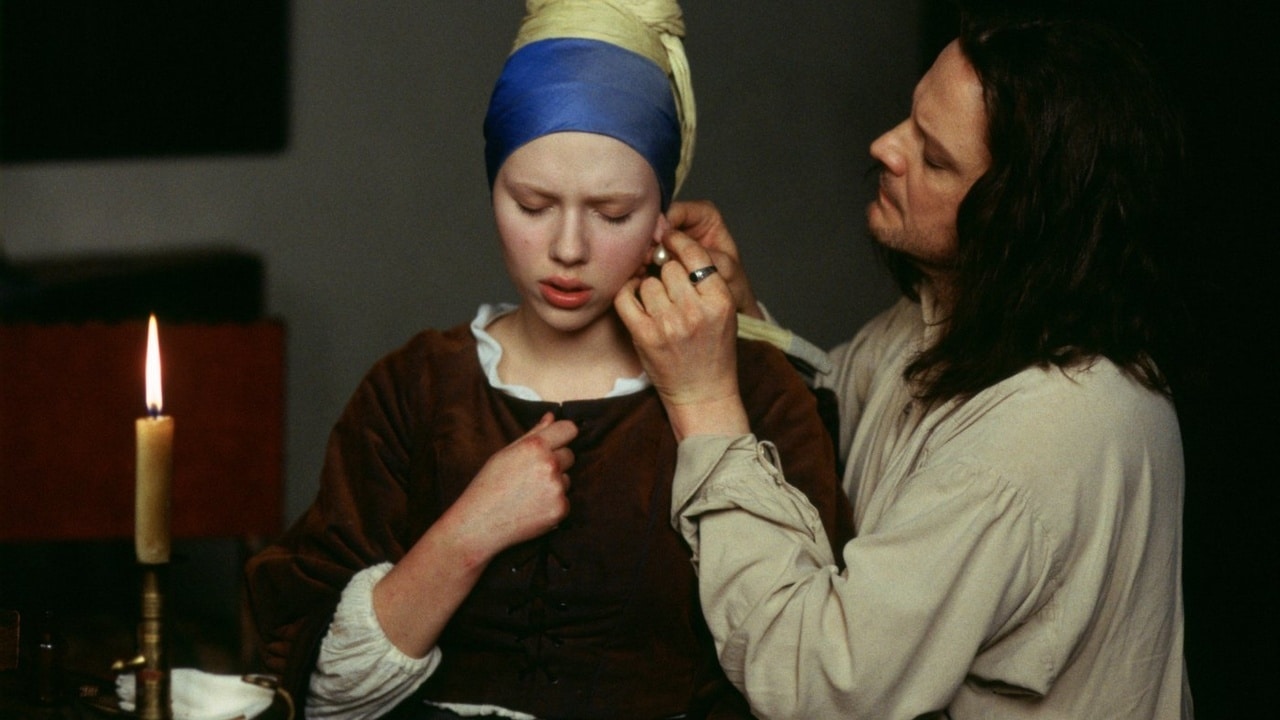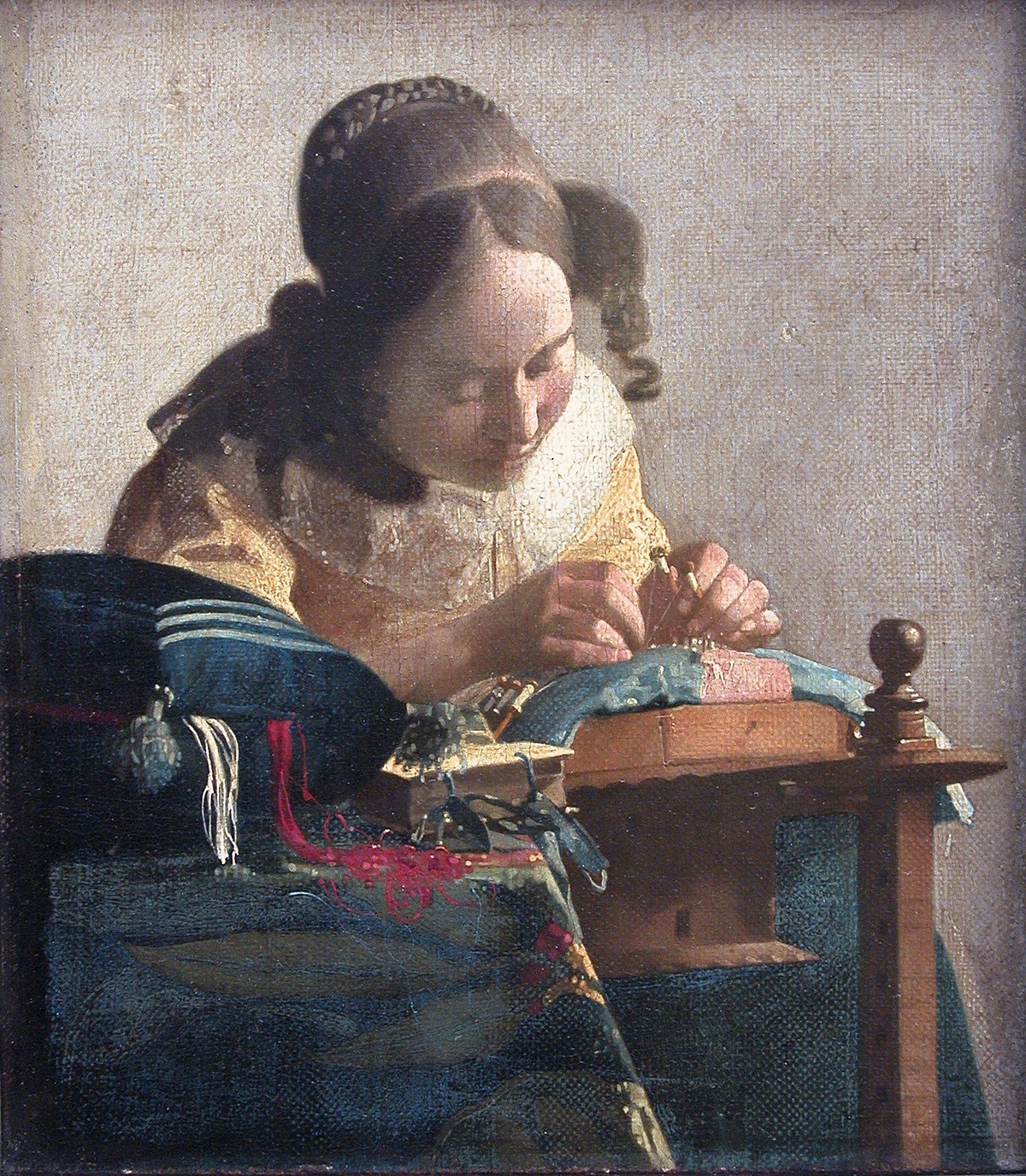How Filmmakers Lose Themselves in the Gaze of Vermeer’s Elusive Girls
The Oscar-nominated Girl with a Pearl Earring, the breakthrough film of a very young Isabelle Huppert and even a legendary, never-finished feature film by Salvador Dalí – many a filmmaker has been inspired by Vermeer’s work. A story about the impossible love between master and maid.
That the seventeenth-century work of Dutch master Johannes Vermeer is still very much alive is evident from the many forms in which we encounter it in everyday life. From Banksy’s graffiti parody Girl with a Pierced Eardrum
to Delft blue tiles, biscuit tins, fridge magnets, printed umbrellas and the good-humoured milkmaid who, in the commercials of a French dairy company, prepares chocolate mousse with Belgian chocolate, vanilla custard for the whole family, or raspberry yoghurt for a painter who looks more like Van Gogh than Vermeer.

In celebration of the decades-long campaign, the advertising agency behind the commercial did not hesitate to stretch the frames of the intimate masterpiece with Photoshop, so as to be able to surround the “craftswoman” with admiring onlookers, “absorbed in a suspended form of ah-ness”. Supposedly as evidence of the “incredible potential for the creative industry”, but in fact artificially fabricated and unattractively flat. Exactly the opposite of Vermeer’s unique, layered handiwork.
What these popular variants are striving for, of course – in imitation of the real thing – is to capture the viewer’s gaze. Ironically, they either resort to impressive formats, wacky gimmicks and exaggerated romantic gaiety, or they stage the desired admiration in the work itself. While the power of Vermeer’s paintings lies precisely in the subtle, unspoken things that are not simply there for the taking. Fortunately, among the filmmakers who were inspired by Vermeer, a more tension-filled image can be found in which there is more to experience. They were inspired by what they saw in the intriguing gaze of Vermeer’s elusive girls.
Of the five feature films discussed below, no fewer than three end with the image of a girl gazing at us, a moment that seems to last forever. In Paul Webber’s Girl with a Pearl Earring (2003), which was nominated for three Oscars, it is the Girl with a Pearl Earring (1665); Jon Jost’s All the Vermeers in New York (1990) ends with Girl’s Head (1667); and in the final shot of Claude Goretta’s The Lacemaker (La Dentellière, 1977), a very young Isabelle Huppert gazes at you in the same spirit as those two portraits. A fourth film, entitled Brush with Fate (2003), with Glenn Close and Jan Decleir among others, about a fictional Vermeer portrait, ends with an empty space in an abandoned house. Letting go of the painting is the trick, advocates that film, otherwise you become captivated, bewitched. That might just be why the fifth film was never finished – The Amazing Adventure of the Lacemaker and the Rhinoceros ( L’Aventure prodigieuse de la Dentellière et du rhinocéros) from the late 1950s, by Salvador Dali and photographer/filmmaker Robert Descharmes.
Master and maid
The recurring theme in all of these films is impossible love. That between master and maid first of all, as in Girl with a Pearl Earring, which is a fictional love story between the Catholic, married Vermeer (Colin Firth) and his Protestant maid Griet (a very young Scarlett Johansson). “Master and maid, the usual story,” scoffs Vermeer’s patron Van Ruijven when he gets wind of the tensions between the two. It’s a cliché. Van Ruijven, who sees in the maid “a ripe plum that’s not yet been plucked”, commissions Vermeer to paint Griet’s portrait. The manipulative Van Ruijven gloats that ordering the portrait is like asking the cat to guard the cream. Vermeer has to manage to produce the work without the knowledge of his jealous wife.
By offering to paint Griet’s portrait, Vermeer tries to keep Griet out of Van Ruijven’s grasping hands. Meanwhile, Vermeer has a spiritual connection with Griet that is pregnant with eroticism but is not consummated. Griet understands the magic of Vermeer’s work, he teaches her that clouds are not white, and she is allowed to mix his paints. She even influences one of his masterpieces when, against all the rules, she moves a chair that was originally in the composition of Woman with Water Jug. Meanwhile, however, you could almost cut the sexual tension with a knife. When Vermeer shows Griet how a camera obscura works, he dives under the sheet covering the large box-shaped device with her. He, the master, gives her, the obliging maid, short commands: “Stay.” “Take off your cap.” Given her visible arousal, there is actually something masochistic about it.
When she refuses to take off her cap in his presence, he peeks longingly at her from behind panels a short distance away, while she puts on a turban in the small room next door, his gaze penetrating, as we can see in the composition of his works. Then it’s “Stay”, “Open your mouth. Lick your lips. Again. And again,” When he then arrives with his wife’s testicle-shaped earrings and pricks a hole in her ear, we witness a strong piece of chaste porn cum symbolic deflowering, about which much has already been written.
How Vermeer has taken possession of her with his gaze is shown when, on seeing her portrait, she remarks startled, “You looked inside me!” The fact that, shortly afterwards, Vermeer’s wife called the canvas obscene and chased Griet out of the house had to do not only with the fact that the girl has her mouth open, which was considered offensive at the time, but also with this openly displayed intimacy.
 The sexual tension is up for grabs in 'Girl with a Pearl Earring'
The sexual tension is up for grabs in 'Girl with a Pearl Earring'Salvador Dalí, who counted Vermeer among his favourite painters, also observed that the endless attraction of Vermeer’s portraits lay in the tension between virginal chastity and charged intimacy. He had already depicted The Lacemaker, which hangs in the Louvre, as a picture in a book in his legendary surrealist short film An Andalusian Dog (Un chien andalou, 1929), in which a man in a stylised seventeenth-century servant’s costume sways his hips sensually on a bicycle.
 Johannes Vermeer, The Lacemaker, circa 1669-1670, The Louvre, Paris
Johannes Vermeer, The Lacemaker, circa 1669-1670, The Louvre, Paris© The Louvre, Paris
In the mid-1950s, Dalí first copied The Lacemaker naturalistically in his own style (Classical Copy of the Lacemaker), only to turn it into a surrealist version (Paranoid Critical Study of Vermeer’s Lacemaker) in which the maid shatters into a multitude of cylindrical shapes, alluding to the horn of a rhinoceros.
Dalí was in his famous rhinoceros period at the time. it was the ambiguity of the horn, Among (many) other things, that fascinated him and reminded him of the compositional form of The Lacemaker: a phallus, which symbolised chastity in the Middle Ages.
He began to work on an unfinished surrealist feature film around Vermeer’s painting, entitled The Amazing Adventure of the Lacemaker and the Rhinoceros. (L’Aventure prodigieuse de la Dentellière et du rhinoceros, filmed between 1954 and 1962), in which he hung an enlargement of Vermeer’s canvas in the outdoor enclosure of a rhinoceros called François at the Vincennes zoo in Paris, hoping that the animal would attack the canvas. When François snorted but failed to charge it, Dali decided to run at the painting and pierced it himself with the lance-sized tusk of a narwhal. Whoever touches the virgin destroys her, that much was clear.
Money and art
When Van Ruijven is alone with Griet’s painting at the end of Girl with a Pearl Earring, he looks like a frustrated man: he could buy her portrait, but possession of the canvas makes it painfully clear to him that the pretty girl herself does not belong to him. There is another impossible love at play here, that between money and art. New York underground filmmaker Jon Jost makes it the subject of All the Vermeers in New York, his improvised, low-budget film interspersed with jazz (1990).
In All the Vermeers in New York, an American stockbroker and a young French actress meet in front of Vermeer’s Girl’s Head at New York’s Metropolitan Museum of Art, which owns a handful of Vermeers thanks to wealthy American businessmen and industrialists who had them shipped from Europe. Mark falls in love with Anna because she reminds him of Vermeer’s elusive girls. But because he projects his ideal onto her, he does not see the young woman herself for who she is. At the museum he forgets time, is momentarily freed from the everyday stress of the trading floor, from his hollow existence that revolves around moving money.
It soon becomes clear that they are not suited to each other. When Mark and Anna stand together on the roof of one of the World Trade Center towers, she enjoys the unobstructed view of Manhattan. He, on the other hand, sees the people like ants in the city below him; he feels as if he is dead, so small. Jost constantly films the back of Anna’s head, as if Mark keeps hoping she will look back at him like Vermeer’s maid, but he is incapable of looking inside her.
When he asks her to move in with him, he notices that something is troubling her. After he insists, she tells him that she is short of money for the sky-high rent of the New York flat she shares with a couple of other art students. When he casually gives her the money she needs – he is standing up, she is sitting down – it exposes the power relationship between them. He looks satisfied, she feels humiliated. The next day, she decides to leave the city and return to her French boyfriend in Paris.
Class differences and gender roles
If anything, Swiss director Claude Coretta’s European art-house film The Laceworker (La Dentellière, 1977) goes even further. It, too, is about a love impossible because of class differences and gender roles. It was the breakthrough film of the then-twenty-one-year-old Isabelle Huppert. She plays the introverted Parisian hairdresser Pomme, raised by her single mother who works in a grocery store. During a holiday at the seaside, Pomme meets literature student François, who comes from a well-to-do family. He deflowers her, but when she moves in with him, he loses interest. She serves as best she knows as the recipient of his love, as she has been taught. He looks down on her passivity, because she does not educate herself like his intellectual friends do, and displays no identity, interest or will of her own other than to please him.
She is the embodiment of an abstract ideal – there to be loved by a man who sees her as such – but is otherwise, as the object of his desire, a blank canvas. When he leaves her, she no longer seems to exist and disappears into a mental institution. Like Vermeer’s girls, she exists only in the rapturous eye of the viewer, anonymous, with no identity or story of her own. Filmmakers jump into that breach, but also seem to realise that they always come out empty-handed. The girls will never be more than a fantasy. In this respect too, they remain elusive. There are no happy endings.
An empty space in an abandoned house
“Is the world really waiting for yet another painting of a woman alone in a room?” sighs Vermeer in the somewhat melodramatic American television film Brush with Fate (2003) to a baker to whom he owes money. From the mouth of the master, it seems like a ridiculous statement. In this frame story, Glenn Close plays a single history teacher who owns an unknown, fictional Vermeer, a portrait of a girl in hyacinth blue.
In a series of short narratives, we learn how various owners of the painting, including Jan Decleir who plays a nineteenth-century sea trader, learned to part with it, for their own good. Those who cannot, like the contemporary owner, played by Close, remain under the spell of the past, obsessed, bewitched. Here there is no enchanting gaze from a girl as the final chord, but an empty space in an abandoned house. The owner has disappeared, painting and all, because she cannot let it go. She lives only for the painting, it consumes her.
Therein lies a task, perhaps, for those who go to see Vermeer’s maids at the Rijksmuseum now, or elsewhere later on: to see how they capture the viewer’s gaze in a moment that seems to last forever, but that the trick is to accept that this moment, this gaze, is elusive, a projection. And to understand that we will never know who they really were, the lacemaker, the milkmaid, the young woman with the water jug, the girl with the pearl earring, the girl reading a letter at the window or the girl’s head. That they are no one’s possessions and are brought to life, at most temporarily, in our own imagination.












